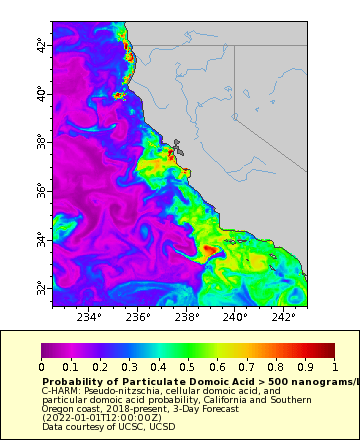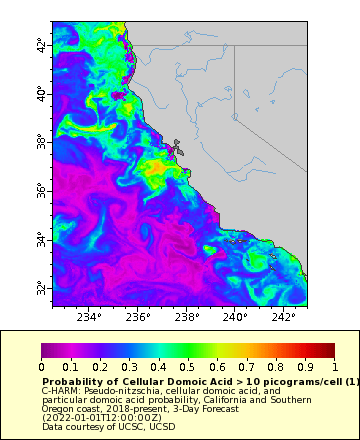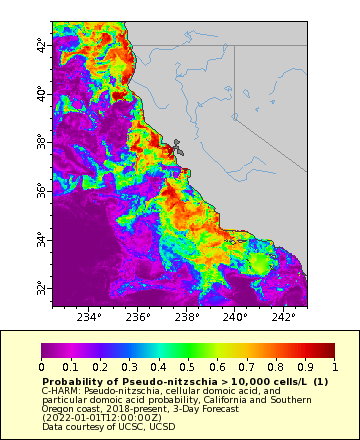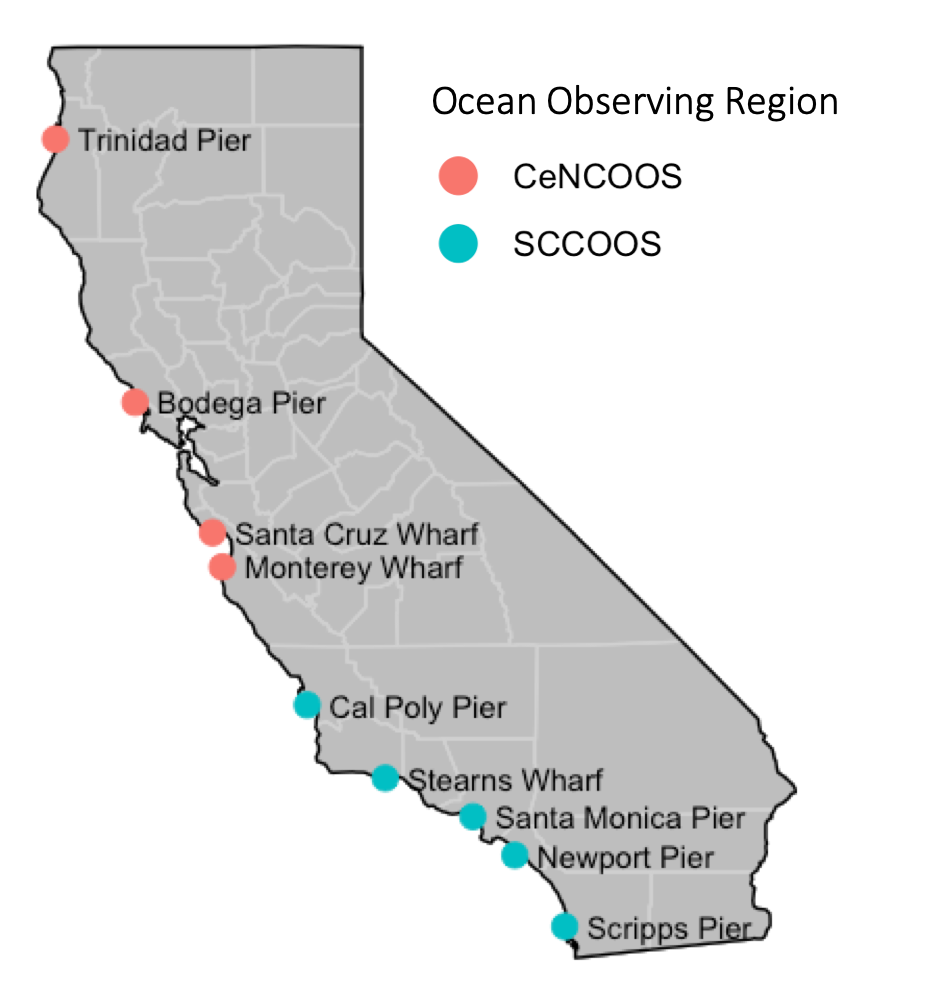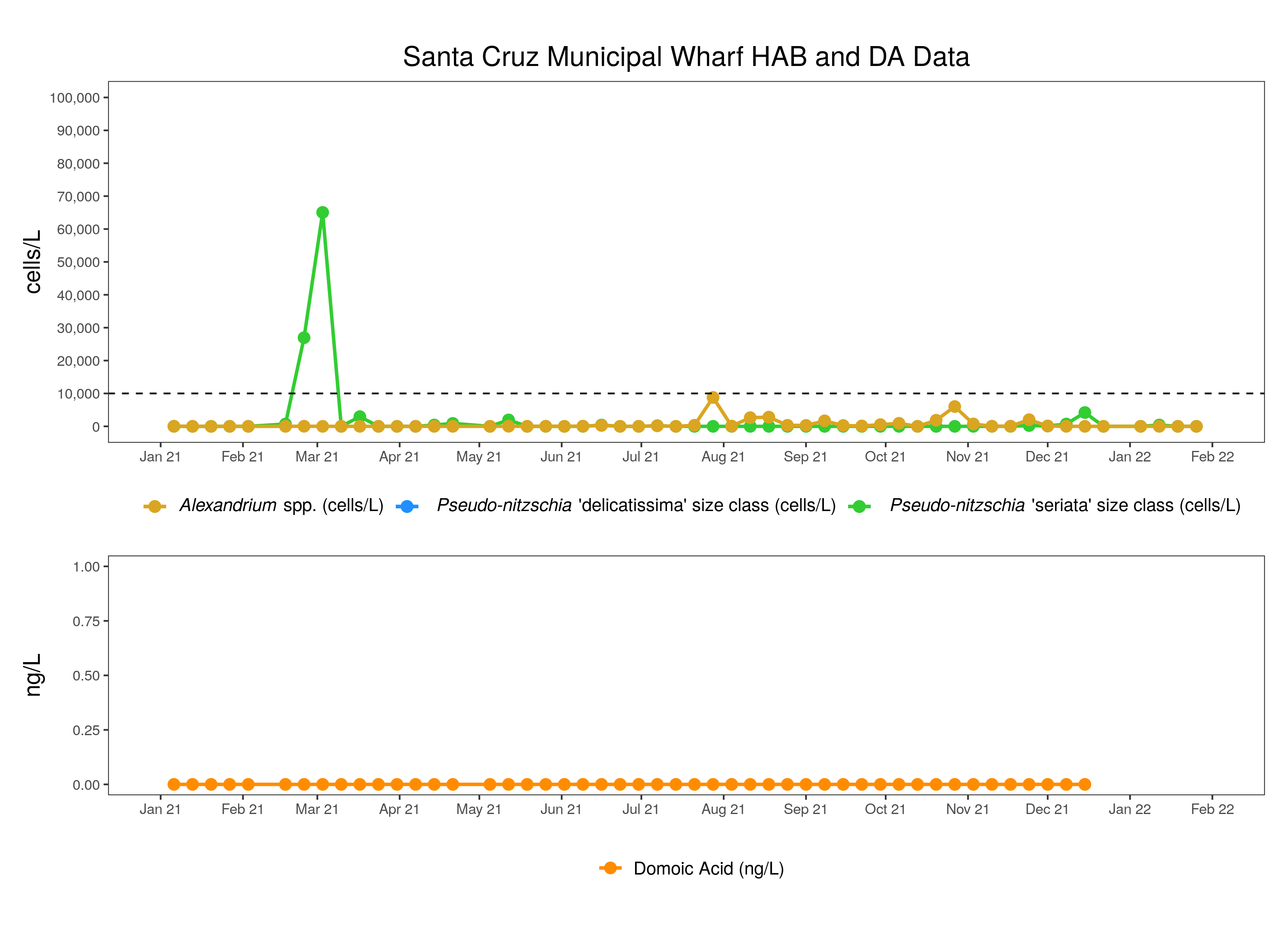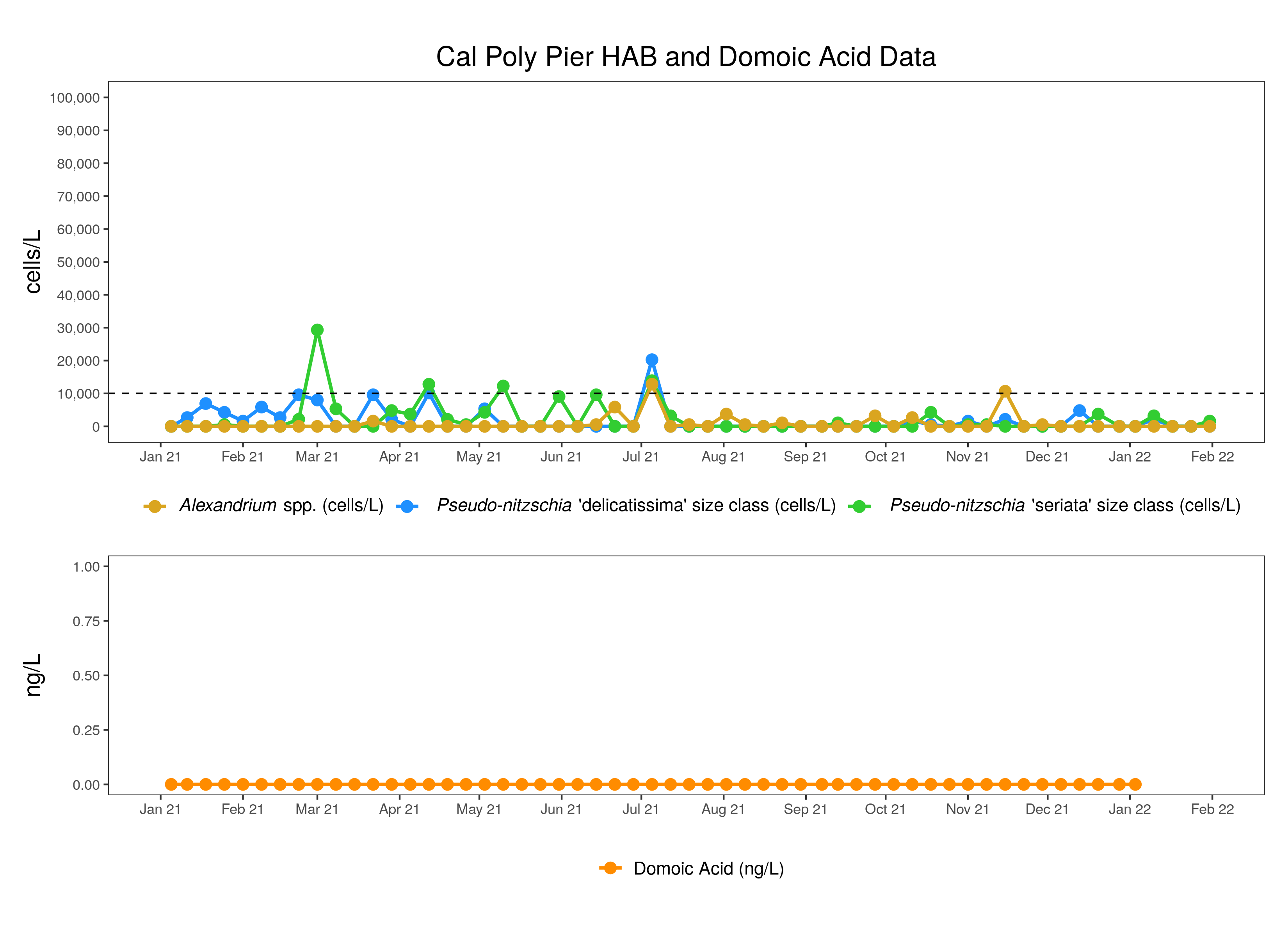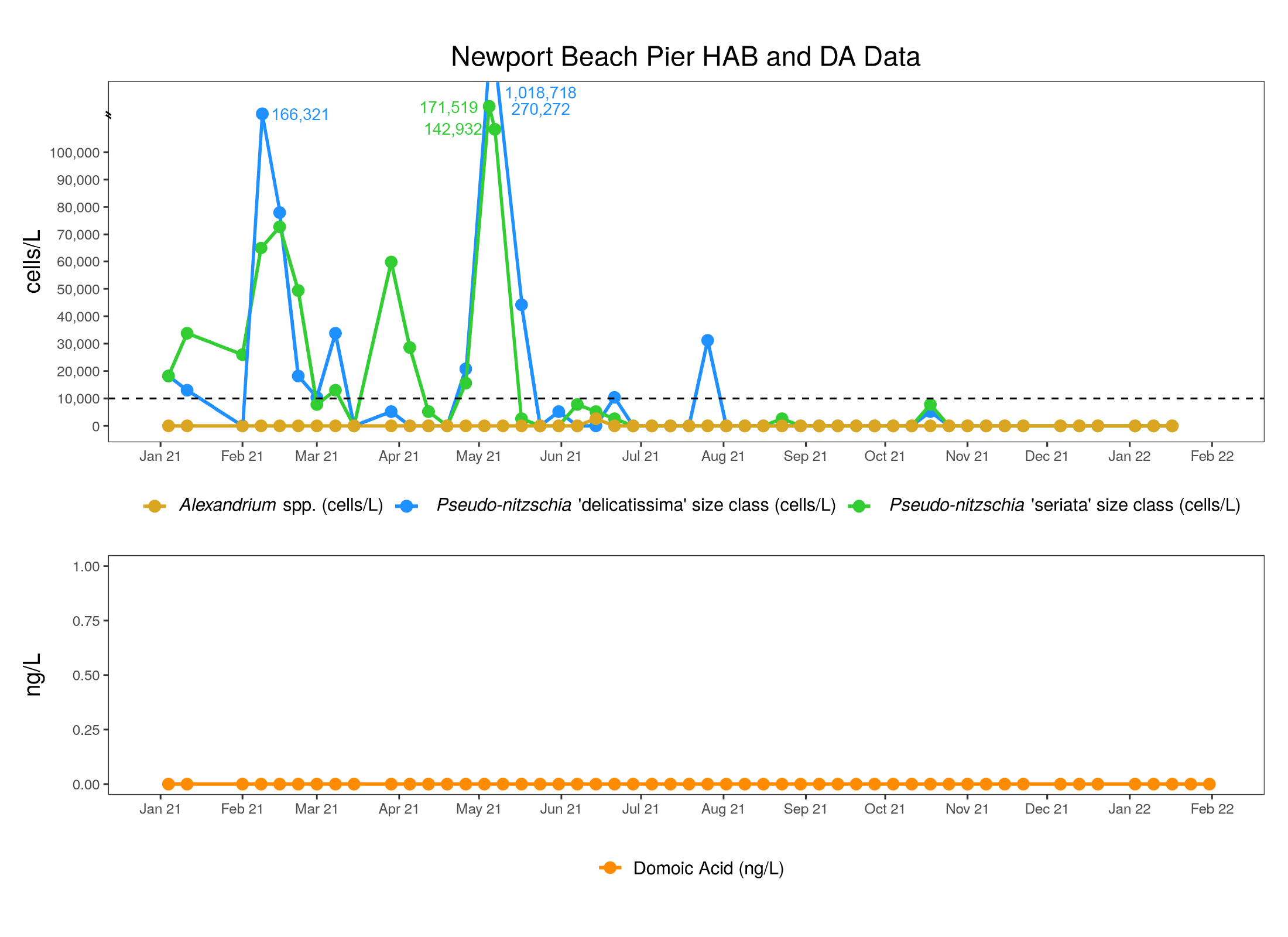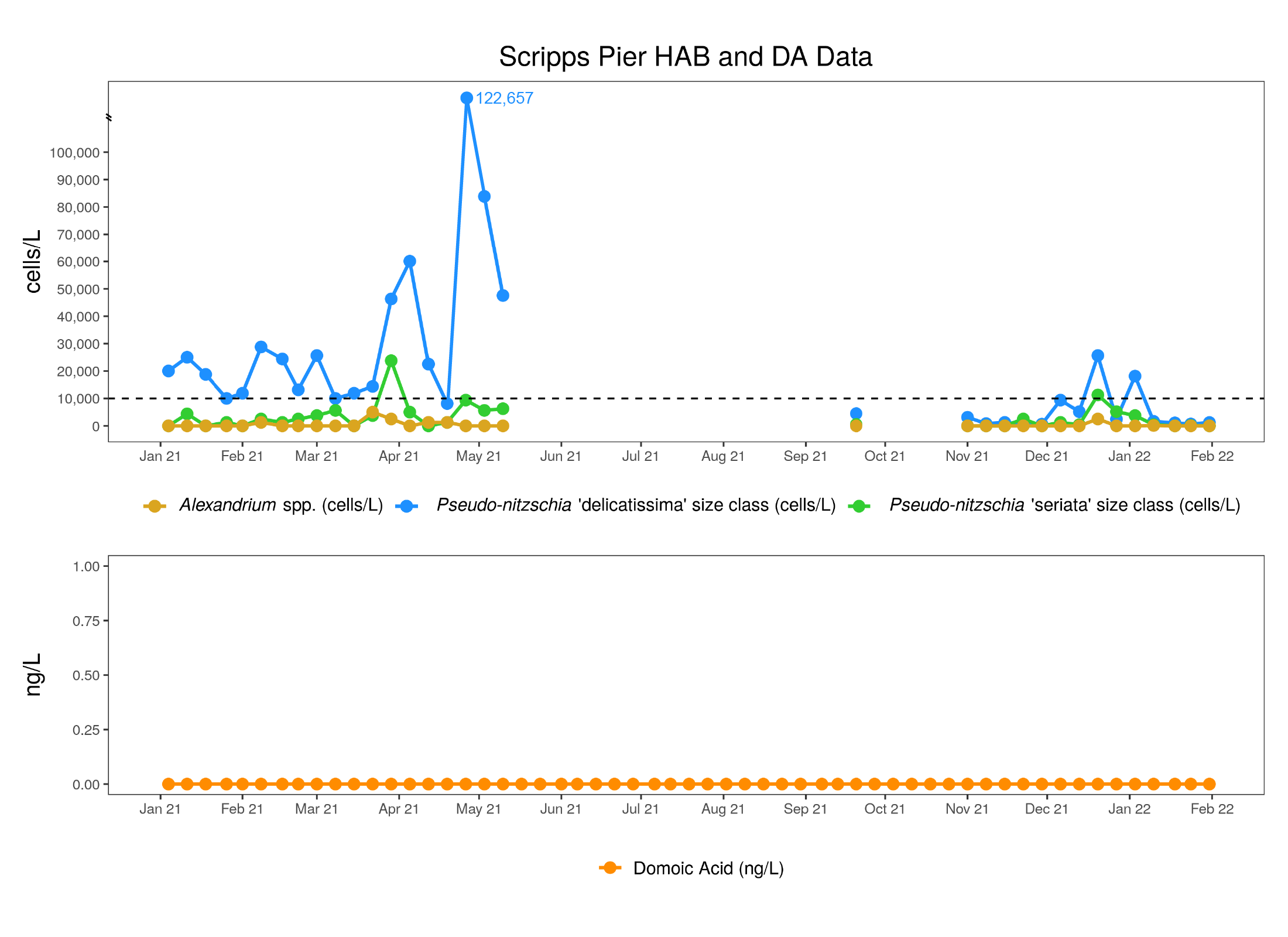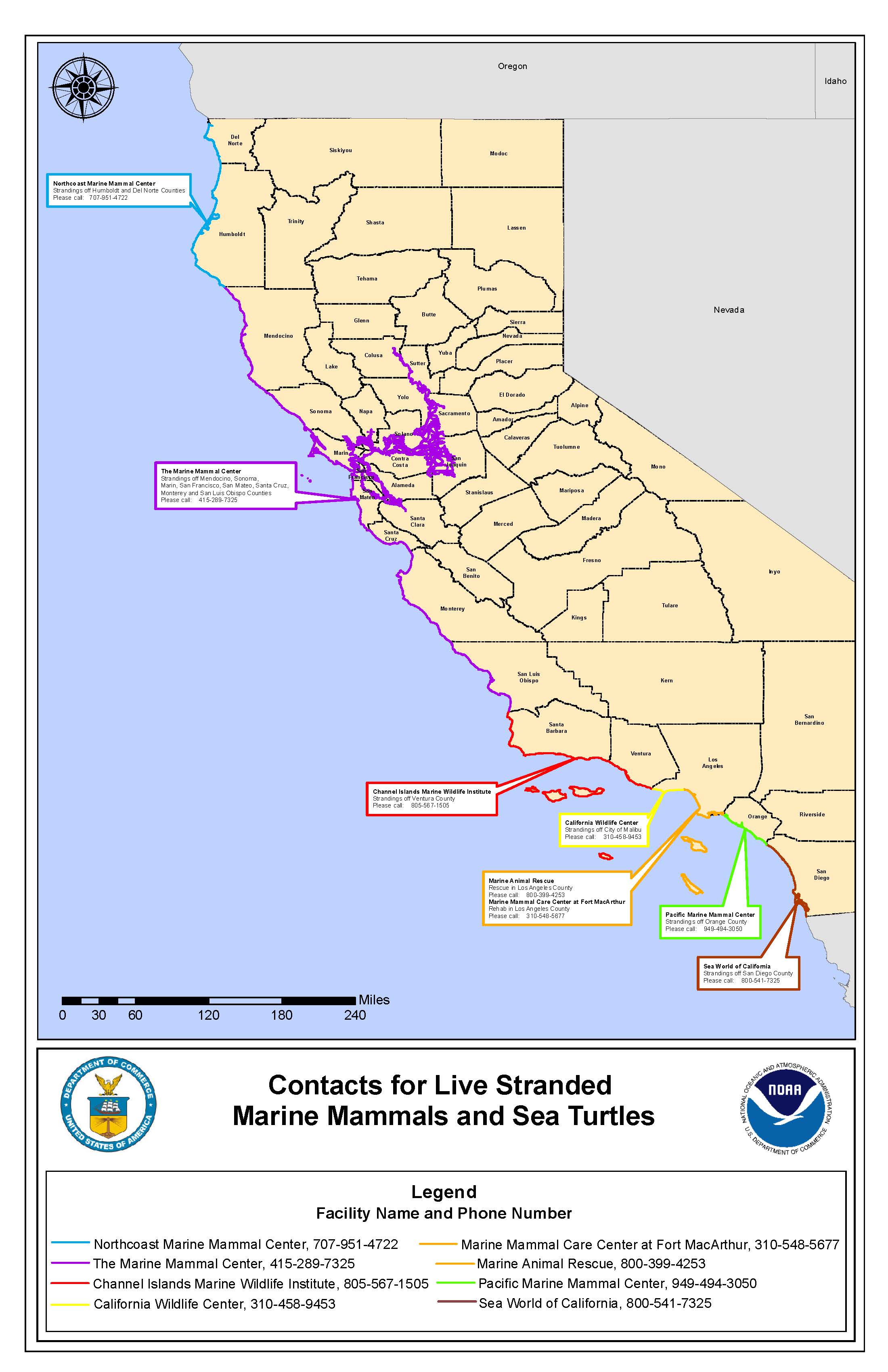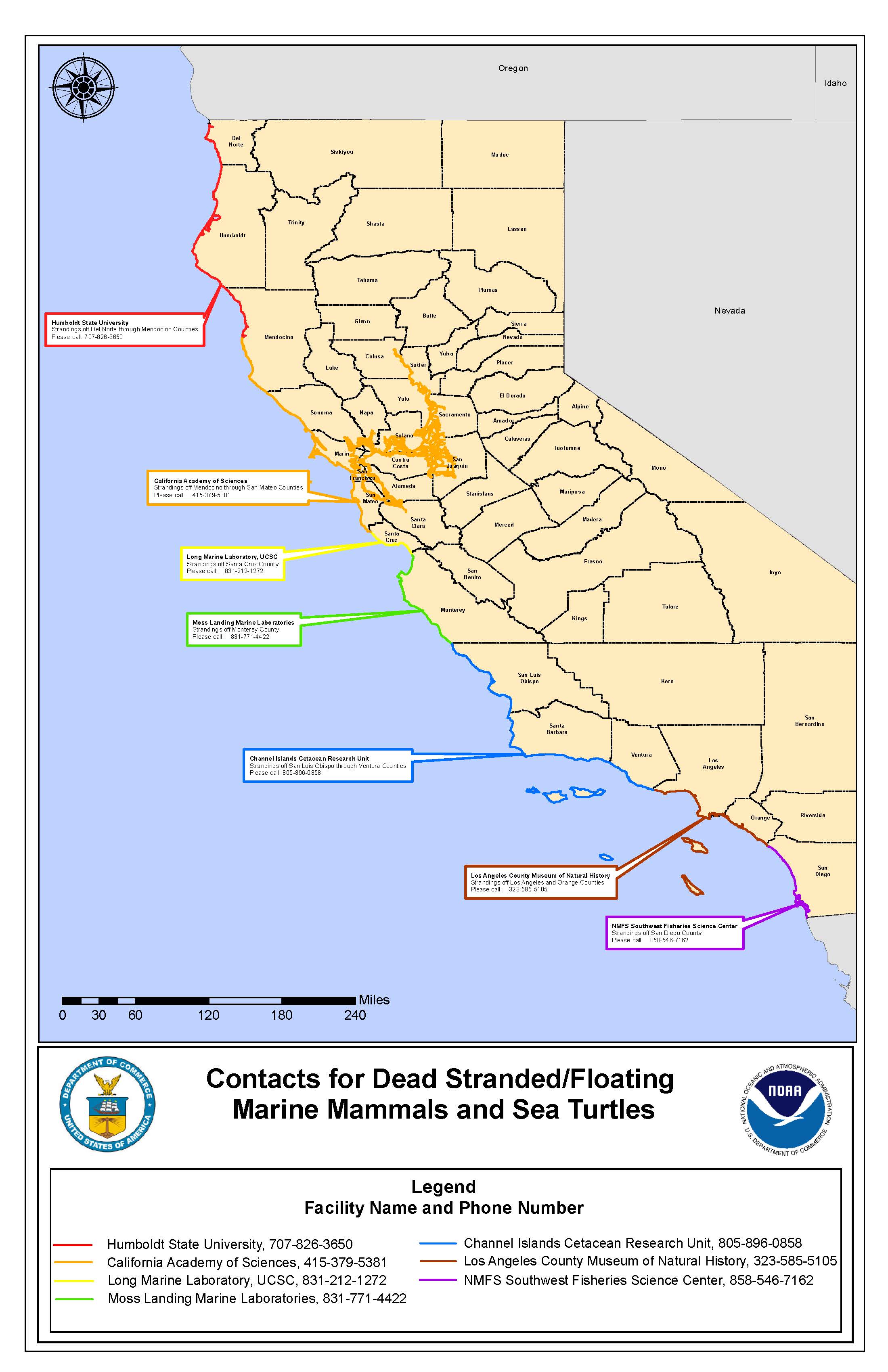JANUARY HIGHLIGHTS
Pseudo-nitzschia -
- C-HARM tells us where conditions are suitable for species of the diatom Pseudo-nitzschia spp. (all size classes) to grow well and where they might be more likely to produce the deadly neurotoxin, domoic acid (DA).
- C-HARM predictions for Pseudo-nitzschia spp. in January were similar to December early in the month but then departed from the recent trend, showing a progression towards smaller areas of high bloom probability that hugged the coast in small portions of the coastline from central to northern CA throughout the month. This is expected climatologically for the month of January, when these blooms and toxic HAB events are generally rare due to winter mixing and storms.
- Compared to the slight ramp up in bloom measurements in December at central and southern California HABMAP pier sampling sites, Pseudo-nitzschia spp. were not seen at bloom levels for either size class in January, except at Scripps Pier on Jan. 3rd when the less toxigenic 'delicatissima' size class breached the 10,000 cell/L threshold. Pseudo-nitzschia spp. were detected at low levels at all other sites throughout the month, indicating that they are very often present at both size classes and poised for an increase in dominance should environmental conditions change.
- Pseudo-nitzschia activity from CDPH sampling was consistent with HABMAP in that the toxigenic 'seriata' size class was observed as "Common" on Jan 3rd at Scripps Pier, however, it was also observed as "Abundant" in the Santa Barbara Channel at Santa Cruz Island despite HABMAP sampling not detecting bloom levels of Pseudo-nitzschia spp. at Stearns Wharf in Santa Barbara. This illustrates the large horizontal variability that exists for plankton and the error inherent in single-site coastal sampling. Like the HABMAP sampling, though, Pseudo-nitzschia was present at many sites from Scripps Pier to Tomales Bay (near SF).
- C-HARM probabilities in January for particulate domoic acid (pDA) were similar to the previous month at first, although with reduced probabilities in most places, except two obvious hot spots: the central coast outside of SF Bay/Half Moon Bay/Monterey Bay and fairly far offshore of the central San Luis Obispo coastline. As the month proceeded, southern portions of the Southern California Bight began to show high pDA probabilities, mostly in an offshore cyclonic eddy. Small sections of the North Coast, close to shore, were also predicted to be a potential problem area for pDA later in the month.
- The cellular domoic acid (cDA) probabilities for January were somewhat consistent with the C-HARM pDA predictions in that the central coast outside SF Bay and SLO to Santa Barbara Counties were predicted to be ephemeral hot spots for cDA events throughout the month, particularly in mid-January. Probabilities briefly exceeded 60% in parts of the Southern California Bight in late January, with some predicted hotspots isolated to the offshore eddy region and some close to the coast.
- Domoic acid data are available for all HABMAP sampling sites in January (except at Santa Cruz Wharf). There was no DA (i.e. no detectable DA) at those pier sites in January despite the presence of Pseudo-nitzschia spp. at most sites.
- There were no cases of potential DA toxicosis recorded by marine mammals rescue centers in the month of January, however, SeaWorld reports are not yet submitted. This is consistent with the more ephemeral nature of high pDA and cDA probabilities as predicted by C-HARM and the zero DA recorded at the pier sites.
- In January, the CDPH health advisory from Dec 16th was still in effect to not eat razor clams caught recreationally in Del Norte County due to the threat of ASP from domoic acid; this may be connected to the high DA predictions coming from the North Coast in previous months and the southern Oregon hot spot noted in December.
Alexandrium -
- CDPH noted that Alexandrium spp. were "Present" at sites in the Santa Barbara Channel and SLO County area, consistent with HABMAP detection of Alexandrium spp. at Stearns Wharf in Santa Barbara. There are currently no advisories for Paralytic Shellfish Poisoning.
*Please note that HABMAP sampling, CDPH sampling, and marine mammal rescues have been greatly reduced in response to COVID-19 safety measures.
Summary written by Clarissa Anderson on January 12, 2022
**HABMAP sampling resumed after being suspended in March 2020 in accordance with the Governor's stay at home order. However, COVID-19 safety protocols and sampling restrictions may continue to affect operations and delay results.**
Note that data for some stations are not shown because they are not yet recorded in the public HABMAP archive.
Differentiating Pseudo-nitzschia species by light microscopy is difficult. For this reason, Pseudo-nitzschia "seriata" does not refer to an actual species but rather the larger size class of Pseudo-nitzschia, which is generally a more toxigenic group of species. Alternatively, Pseudo-nitzschia "delicatissima" refers to the smaller size class that is generally non-toxigenic. The dashed line on the plots demarcates the 10,000 cells/L "bloom" threshold designated here for Pseudo-nitzschia populations only.
More information and data visualizations on the statewide HAB network and forecasting system can be found on the California HABMAP website and on the SCCOOS Harmful Algal Bloom page.
Santa Cruz Wharf
Four water samples were collected at Santa Cruz Wharf in January. Molecular probes for toxigenic Pseudo-nitzschia in the "seriata" class are conducted for this site, and was detected once on January 12 below the bloom threshold. Alexandrium spp. were not detected. Domoic acid results are not yet available.
The Santa Cruz Wharf shore station is supported by CeNCOOS PI Raphael Kudela at UCSC.
Cal Poly Pier
Five water samples were collected at Cal Poly Pier in January. Pseudo-nitzschia "delicatissima" was detected once (January 10) below the bloom threshold. Pseudo-nitzschia "seriata" was detected twice (January 10, 31), also below the threshold. Alexandrium spp. were not detected. Domoic acid was not detected in the first sample, but remaining sample results are still pending.
Cal Poly Pier shore station is supported by SCCOOS and PIs Ryan Walter and Ally Pasulka at Cal Poly.
Stearns Wharf
Two water samples were collected at Stearns Wharf in January. Pseudo-nitzschia "delicatissima" and Pseudo-nitzschia "seriata" were detected on each occasion (January 2, 10), both below the bloom threshold. Alexandrium spp. were detected on January 2. Domoic acid was not detected in the first sample, but the last sample is pending analysis.
Stearns Wharf is supported by SCCOOS and PIs Mark Brzezinski and Libe Washburn at UCSB.
Santa Monica Pier
Five water samples were collected at Santa Monica Pier in January. Pseudo-nitzschia "delicatissima" was detected once (January 3) below the bloom threshold. Pseudo-nitzschia "seriata" was detected on three occasions (January 10, 24, 31), all below the bloom threshold. Alexandrium spp. and domoic acid were not detected.
The Santa Monica Pier shore station is supported by SCCOOS and PI Rebecca Shipe at UCLA.
Newport Beach Pier
Five water samples were collected at Newport Beach Pier in January. Pseudo-nitzschia "delicatissima", Pseudo-nitzschia "seriata", Alexandrium spp., were not detected in the first 3 samples (January 3, 10, 17). Samples from January 24, 31 are still pending analysis. Domoic acid was not detected.
Newport Beach Pier is supported by SCCOOS and PI David Caron at USC.
Scripps Pier
Five water samples were collected at Scripps Pier in January. Pseudo-nitzschia "delicatissima" was detected on each occasion (January 3, 10, 18, 24, 31), with the first sample above the bloom threshold. Pseudo-nitzschia "seriata" was detected on 3 occasions (January 3, 10, 24), all below the bloom threshold. Alexandrium spp. were detected once on January 10. Domoic acid was not detected.
Scripps Pier is supported by SCCOOS and PIs Melissa Carter and Clarissa Anderson at UCSD.
CDPH observations for Pseudo-nitzschia "seriata" and Alexandrium spp.
You can view the interactive map and data table of California Department of Public Health (CDPH) data from January 2019 to present, developed by SCCOOS, below. Or, view CDPH Toxic Phytoplankton Observations Map with layers of Pseudo-nitzschia and Alexandrium spp. as well as other phytoplankton species observations (in the pop-up windows).
Data are provided by the Environmental Management Branch of the CDPH. Please note, starting in July 2019, CDPH moved to only reporting Pseudo-nitzschia of the seriata complex and not all Pseudo-nitzschia spp. as previously provided.
Please email CDPH at Susan.Paulukonis@cdph.ca.gov for any potential marine HAB-related illness in humans.
From January 1-31 2022, water samples were collected by volunteers and sent to the California Department of Public Health (CDPH) for analysis.
Pseudo-nitzschia "seriata" group was detected in 35 of the 82 samples:
Pseudo-nitzschia "seriata" was detected at "Abundant" density levels on 1 occasion:
- 2022-01-21 52% Santa Cruz Is., Scorpion Anch.
Pseudo-nitzschia "seriata" was detected at "Common" density levels on 1 occasion:
- 2022-01-03 13% La Jolla, Scripps Pier
Pseudo-nitzschia "seriata" was detected at "Present" density levels on 18 occasions:
- 2022-01-03 5% Tomales Bay, Lease #M430-15
- 2022-01-07 2% Bolsa Chica
- 2022-01-10 1% La Jolla, Scripps Pier
- 2022-01-10 5% Port San Luis, Diablo Cove
- 2022-01-12 4% Imperial Beach Pier
- 2022-01-12 8% Palos Verdes, OFFSHORE
- 2022-01-13 6% Goleta Pier
- 2022-01-17 5% Tomales Bay, Lease #M430-15
- 2022-01-18 1% Cayucos Pier
- 2022-01-19 4% Goleta Pier
- 2022-01-24 1% La Jolla, Scripps Pier
- 2022-01-26 1% Goleta Pier
- 2022-01-27 3% Santa Barbara Ch., Naples Pt
- 2022-01-28 2% Drakes Bay, Chimney Rock LBS
- 2022-01-28 4% Port San Luis, Diablo Cove
- 2022-01-30 4% Pacifica Pier
- 2022-01-31 1% Morro Bay, Boat Launch
- 2022-01-31 2% Tomales Bay, Lease #M430-15
Pseudo-nitzschia "seriata" was detected at "Rare" density levels on 15 occasions:
- 2022-01-02 0.5% Point Richmond, Ferry Point
- 2022-01-03 0.5% Agua Hedionda Lagoon
- 2022-01-05 0.5% Goleta Pier
- 2022-01-06 0.5% Imperial Beach Pier
- 2022-01-09 0.5% Tomales Bay, Lease #M430-15
- 2022-01-14 0.5% Bolsa Chica
- 2022-01-14 0.5% Newport Bay, Back Bay
- 2022-01-18 0.5% Pacifica Pier
- 2022-01-20 0.5% San Clemente Pier
- 2022-01-21 0.5% Bolsa Chica
- 2022-01-24 0.5% Tomales Bay, Lease #M430-15
- 2022-01-25 0.5% Santa Cruz, Seacliff Pier
- 2022-01-26 0.5% Pillar Point
- 2022-01-27 0.5% Bodega Harbor, USCG Dock
- 2022-01-28 0.5% Bolsa Chica
Alexandrium spp. were detected in 14 of the 82 samples:
Alexandrium spp. were not detected at "Common" density level.
Alexandrium spp. were detected at "Present" density levels on 4 occasions:
- 2022-01-05 2% Goleta Pier
- 2022-01-10 4% Port San Luis, Diablo Cove
- 2022-01-18 1% Cayucos Pier
- 2022-01-28 2.5% Port San Luis, Diablo Cove
Alexandrium spp. were detected at "Rare" density levels on 10 occasions:
- 2022-01-06 0.5% Imperial Beach Pier
- 2022-01-12 0.5% Imperial Beach Pier
- 2022-01-13 0.5% Bodega Harbor, USCG Dock
- 2022-01-13 0.5% Catalina Island, Avalon Bay
- 2022-01-19 0.5% Imperial Beach Pier
- 2022-01-19 0.5% Goleta Pier
- 2022-01-25 0.5% Santa Cruz, Seacliff Pier
- 2022-01-27 0.5% Imperial Beach Pier
- 2022-01-27 0.5% Santa Barbara Ch., Naples Pt
- 2022-01-28 0.5% Drakes Bay, Chimney Rock LBS
CDPH and OEHHA Health Advisories
December 16. The California Department of Public Health (CDPH) is advising consumers not to eat sport-harvested razor clams from Del Norte County due to dangerous levels of naturally occurring domoic acid, also referred to as Amnesic Shellfish Poisoning, being detected.
November 29. The California Department of Public Health (CDPH) has lifted the shellfish safety notification for Dungeness crab caught in state waters from the Sonoma/Mendocino County Line (38° 46.125' N. Latitude) to Point Reyes (38° N. Latitude) in Marin County.
November 5. Due to the detection of elevated levels of domoic acid, a naturally occurring toxin, the California Department of Public Health (CDPH) is warning consumers not to eat the viscera (internal organs) of Dungeness crab caught in coastal waters.
For the latest closures and updates, please visit the CDPH Health Advisories page as a central location of information related to CDPH health advisories. Also available is a map showing the current CDPH Recreational Bivalve Shellfish Advisories (see below).
NEWS: The HAB-related illness workgroup has developed a new webpage for marine HAB-related illness tracking work (https://oehha.ca.gov/fish/general-info/marine-harmful-algal-bloom-hab-related-illness-tracking).
California Marine Mammal and Seabird Strandings from Suspected DA Toxicosis
Domoic acid (DA) is a potent neurotoxin produced by some diatom species of the genus Pseudo-nitzschia. Species exposed to DA can result in seizures, epilepsy, cardiomyopathy, and death depending upon the ingested dose. DA toxicosis commonly occurs in California Sea Lions (Zalophus californianus), presumably due to a combination of foraging behavior and seasonal movements. The Marine Mammal Center (TMMC), Channel Islands Marine Wildlife Institute (CIMWI), California Wildlife Center (CWC), Marine Mammal Care Center Los Angeles (MMCC-LA), Marine Animal Rescue (MAR), the Pacific Marine Mammal Center (PMMC), and SeaWorld act like an emergency room by working to rescue and rehabilitate sick and injured marine mammals, seabirds, and sea turtles.
The PMMC, MMCCLA, CWC, MAR, TMMC, CIMWI did not record any strandings due to suspected domoic acid in January 2022.

